Review for Laputa: Castle In The Sky - Double Play: The Studio Ghibli Collection
Introduction
May brings not one, but two doses of high definition Ghibli excellence to UK shores, and I have already taken a look at Isao Takahata's My Neighbours The Yamadas. I could get used to a regular delivery of Studio Ghibli in this way, but that's unlikely to happen. They are taking their time over each back catalogue film that is released on Blu-ray, and only now has the Japanese announcement of the next title been made, Whisper of the Heart if you're interested. It will be quite a while before we see it here, and quite frankly it's more likely that we will see Arrietty on Blu-ray before then. But I have been looking forward to what a Miyazaki creation would look like on Blu-ray; after all, he is the master of fantasy animation. The level of detail, the scope of imagination, the sheer magic of the stories that he brings to the screen quite understandably leads to him being labelled as the Japanese Disney. I missed out on Nausicaa, the first back catalogue Ghibli title that Optimum Entertainment released on Blu-ray, which makes Laputa: Castle in the Sky my first encounter with Miyazaki at 1080p. In a way it's fitting, as Laputa: Castle in the Sky was the first animated feature made under the Studio Ghibli banner. The last time I saw this was on an SD Film Four broadcast, so I have to own up to a little eager rubbing of hands as I placed the disc into the player.
Laputa: Castle in the Sky is released on Double Play Blu-ray and DVD, but I only received the Blu-ray check disc for review, so I won't be comparing and contrasting here.
When a girl falls into your lap, some sort of adventure is pretty much guaranteed by the laws of narrative. But for Pazu, when Sheeta drops into his arms after falling thousands of feet from an airship, it heralds the most fantastic adventure imaginable. Sheeta is a young orphan with a legacy that leaves her much in demand. She was being 'escorted' on the airship by the military and a rather enigmatic Colonel named Muska, when air pirates attacked, looking to kidnap her. She used the opportunity presented by the pirates to slip free from her guards, but she wasn't too keen on joining the pirates either, which is how she wound up falling from the sky into young mineworker Pazu's arms. Luckily, keeping her safe was a mysterious crystal necklace, which allowed her to float down from the sky like a feather. It's a crystal that she inherited from her mother, and a crystal that comes from the mythical floating island of Laputa.
Pazu has a connection of his own to Laputa. His father once claimed to have found the island, even managed to capture a photograph of it, but he was denounced as a liar and died a broken man. Since then, Pazu has been fascinated by flight, and determined to one day build a plane and find Laputa himself, to prove his father's integrity. The two orphans quickly become friends, and promise to find Laputa together, but others have different ideas. The military wants to find Laputa to exploit its technology and build better weapons, while the pirates want to plunder the island for its fabled riches. Both believe that Sheeta and the crystal she wears will point the way. It's just a matter of who will get to her first, and Pazu promising to keep her safe will not be enough. It turns out that the fate of Laputa; the fate of the world itself lies buried in Sheeta's past.
Picture
Laputa: Castle in the Sky gets a 1080p 1.85:1 widescreen transfer. The film has had a bit of a spring clean. Signs of print damage and age are wholly absent; in fact the only thing dating the film is the comparative crudity of the character designs and animation technique when compared to more recent films like Spirited Away or Howl's Moving Castle. There's a light sheen of film grain as you would expect, but more prominent is a slight cine wobble to the feature, to be expected when you're photographing one frame at a time and then swapping out cels. The clarity is superb, the smoothness of the animation displayed at its native 24 frames per second is astounding, and the higher definition means that issues like aliasing, colour banding or even those NTSC-PAL conversion issues indicative of some anime DVDs, are a total non event when it comes to Blu-ray. There were one or two moments of comparative softness to the image that did nudge it down in my estimation, but it's certainly not enough to reduce enjoyment of the film.
Laputa dates from 1986, which makes its newness on the Blu-ray almost work against it when it comes to the character designs. They are typical Ghibli, and you can see the way that they will eventually evolve into the characters that you see in films like Spirited Away, but in Laputa they are comparatively lacking in detail, and on the Blu-ray that lack comes across. They almost feel unfinished for want of a better word, especially the central characters of Sheeta and Pazu. The pirate Dola and her crew are more distinctively drawn though. The characters are one thing, the world designs and fantastic steampunk technology depicted in Laputa is something else, beginning with the impressive airships, the bumblebee-like air scooters the pirates ride, to the cliff-side mining town where Pazu lives, inspired by the Welsh valleys. Of course there is the world of Laputa itself, the weird menagerie of animals and the forbidding robots that inhabit it. In these respects, the film definitely is a feast for the eyes.
The images in this review are sourced from the PR material, and aren't necessarily representative of the Blu-ray disc.
Sound
It's a smorgasbord for the ears too, with the option of LPCM 48k 5.1 English, and 2.0 Japanese, with optional English subtitles. I went with the original language track, which I found to be rich and vibrant, and even with a bit of presence given a little Prologic nudge. The dialogue is clear, and the film's action and music comes across without flaw. It's certainly enjoyable this way. I sampled the English dub (the more recent Disney dub), and it's another quality effort with some heavy Hollywood hitters in the cast, not least of who are Cloris Leachman, Mandy Patinkin, and Mark Hamill. For the dub, Disney apparently took on the services of Joe Hisaishi to add to his score, so the English version has a lot more music to it, which I'm not as keen on. Having said that, the 5.1 audio is more than just a simple upmix, and the sound design works really well bringing across the action and enveloping the viewer in the film. I know I'm blaspheming by even thinking this, but I did wonder if the Japanese audio could have received a similar embellishment.
The subtitles are clear and free of error, but I have decided that I do not like the font. It's uneven and distracting, where all those letters that exist beneath the line, the 'g's, 'y's, 'p's, and 'q's of this world all get nudged up so they look uneven in the sentence.
Extras
I received only the Blu-ray check disc, so I can't comment on the packaging. The disc does offer animated menus, and it also has multi-angle credit sequences, depending on which language you choose to watch the film in. Some of the extras have been ported over from the DVD, and some are new to this release.
The picture-in-picture storyboards allow you to watch the film with a small box of pencil sketch in the corner of the screen. I think this is a step back from the DVD, or at least the other Ghibli DVDs that I have seen, that allow you to see the storyboards full screen via the multi-angle option if you choose.
The Promotional Video lasts 13 minutes and offers an SD quality interview with Hayao Miyazaki and his staff as they talk about creating Laputa: Castle in the Sky. This is a contemporary piece made while the film was under production.
For a more reflective look, there are the Behind The Studio featurettes, HD quality interviews with Hayao Miyazaki and his producer Toshio Suzuki looking back at the making of Laputa from a perspective today, 25 years on. The World of Laputa lasts 2 minutes, Creating Castle in the Sky lasts 4 minutes, Characters Sketches lasts 3 minutes, and Producer's Perspective: Meeting Miyazaki lasts 3 minutes.
Behind the Microphone lasts 4 minutes and offers brief views from the English voice actors who dubbed the film for Disney, among them Mandy Patinkin, Cloris Leachman, Mark Hamill, and James Van Der Beek.
The textless credits are presented in HD and last 5 minutes, while the original Japanese trailers, also in HD last 4 minutes. Finally there is a batch of Studio Ghibli trailers, Nausicaa, Ponyo, Howl's Moving Castle, Tales From Earthsea, My Neighbours The Yamadas, and Spirited Away.
Conclusion
Laputa is a big film, a rich, vibrant, a colourful story, long at just over two hours, with a lot of imaginative and thought provoking ideas expressed within, and some wonderfully complex and interesting characters. It's a whole lot of film to experience, but the review is devilishly simple to articulate. Laputa: Castle in the Sky is a fun and thrilling adventure for all the family.
So now what do I talk about for the next few paragraphs? I was a latecomer to the world of Studio Ghibli. My first exposure to it was along with most everyone else, through Spirited Away, and it was positive reviews that led me to try Kiki's Delivery Service next. It wasn't until Film Four got the rights to broadcast the studio's catalogue that I approached the films with any determination, and Laputa: Castle in the Sky was the first film that I saw this way. It's then that I realised just what a master storyteller Hayao Miyazaki is.
It's a very different, simple and direct storytelling that has long been out of vogue with US studios. Western animation has for quite a while now been focused on gags, wisecracks, winks to the audience, in an attempt to get parents' bums on seats alongside the little 'uns. The story often comes off second best in such a scenario, although Pixar does usually find a decent balance. Studio Ghibli films are all about the story first and foremost, and Hayao Miyazaki excels in children's fantasy adventures. Laputa, dating from 1986 is a relatively early entry into the Ghibli canon, but it is as perfectly formed, as entertainingly told as any of the more recent films.
The PR material quite appropriately refers to the film being Miyazaki's homage to Jules Verne and Jonathan Swift. Certainly the floating island of Laputa owes much to Gulliver's travels, while you can sense the stirrings of steampunk, in the way that technology develops in the world of Castle in the Sky. There's Miyazaki's perennial fascination with flight in this world of airships and little bumblebee hover-planes. There's something very evocative of the vision of sky pirates, so much that it would be revisited in Porco Rosso. Here Dola and her band of pirates operate from a swift airship, going up against the might of the military, and their battleship of the sky. The search for a mythical lost world very much echoes the literature of Verne and his contemporaries, but there are also the more fundamental myths of Atlantis and the like infusing the story.
Certainly, when you have children on an adventure seeking lost cities, resolving their pasts, with treasure and power at stake as well, it's practically a perfect mix for family entertainment. It's not surprising that I see echoes of The Mysterious Cities of Gold in this film, although that television series never had the budget, intricacy or scope of the film, let alone the depth and engaging writing. Miyazaki's constant themes of growth and the loss of childhood innocence are also apparent here, with Pazu and Sheeta the two orphans facing adversity. That they are orphans is a challenge enough, but both have legacies that they have to overcome, Sheeta's connection to Laputa, and for Pazu it's proving his father's veracity. The adult world is the enemy for the children, with both the military and the pirates wanting to possess the secrets of Laputa. It's a childhood fantasy that Pazu wants to protect Sheeta from both these foes, but reality is never so kind. Both of the children have to grow up and face reality, they have to weigh the lesser of two evils, and in the end, they have to take responsibility for their actions.
Miyazaki also manages to sneak in his messages on the corruption of power and eco-awareness. The corruption is easy to locate, with the military hell bent on plundering Laputa for its secrets, and intent on gaining its power, to whit weapons. It's no surprise after seeing what the one Laputan robot that they recover is capable of. Then there is Colonel Muska, who ostensibly works for the military in chasing down Sheeta, but in fact has far more insidious motives. As usual, the children manage to maintain their purity and innocence, while it's the adults who succumb to greed and lust for power. The eco message is a little subtler in Laputa, but hard to dispute when you learn what the Laputan robot's true purpose is.
Every time I look at the 125-minute runtime of Laputa, I feel a little daunted at an anime of that length. But every time I sit down and watch it, the hours just melt away, as I lose myself in an incredible action adventure. On Blu-ray, Laputa looks absolutely divine. Having now seen both this and My Neighbours The Yamadas in high definition, I'm practically whimpering in anticipation of more Ghibli on Blu-ray.
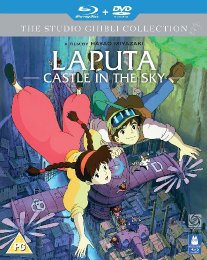
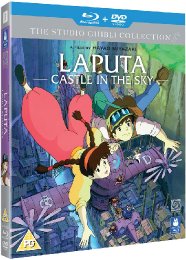




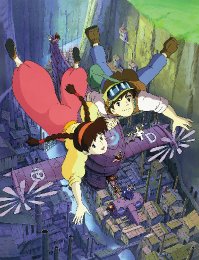
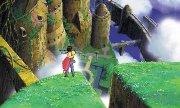
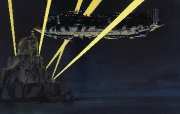
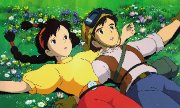

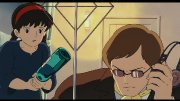
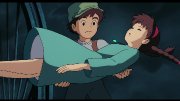
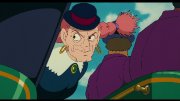
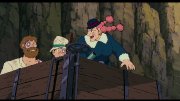
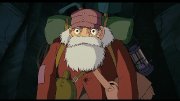
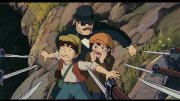
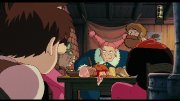
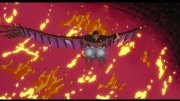
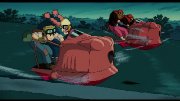
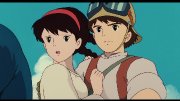
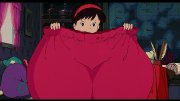

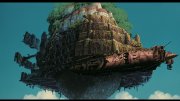



































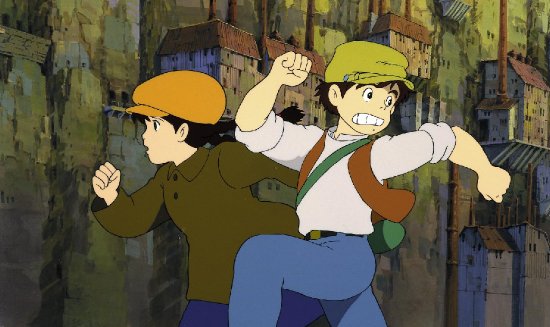
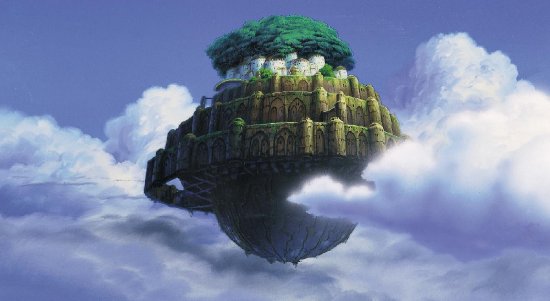


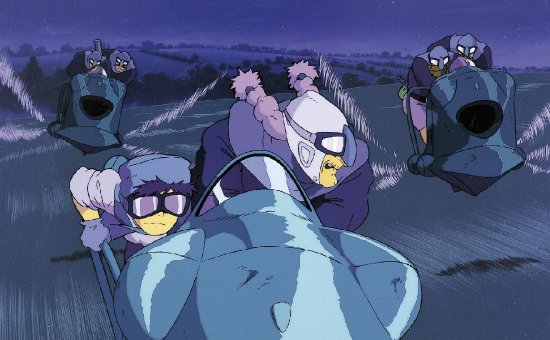

Your Opinions and Comments
Be the first to post a comment!